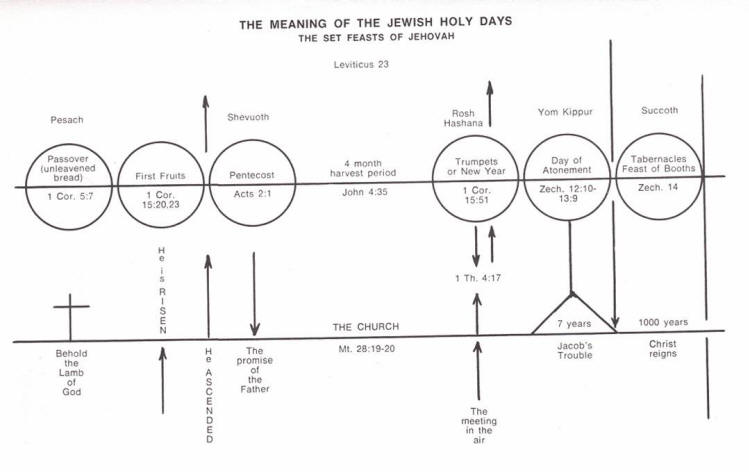
The
Seven-Feasts of Israel:
the First and Second Coming of Messiah
7. The Feast of Weeks (Shavuot)
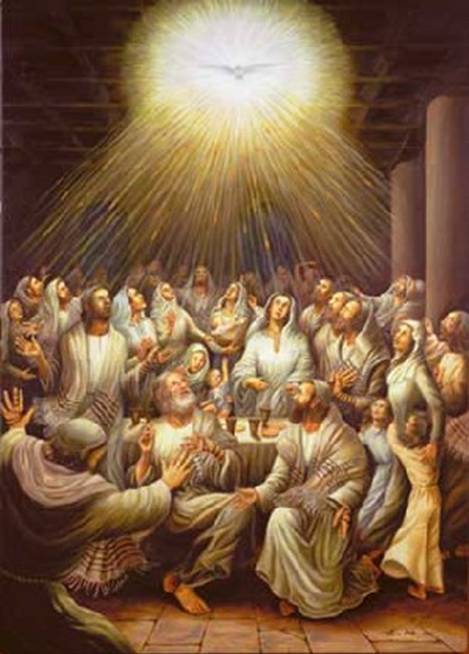 The
feast of Pentecost is also known as the Feast of Weeks. This feast day plays
a significant role in the “Church”. This is the day the Holy Spirit came
upon the believers gathered in the upper room. The Feast of Pentecost given
in the book of Leviticus, and the Holy Spirit coming upon the church, is the
fulfillment of the shadow of the Law. In the same way Jesus fulfilled the
first three feasts, in His death, burial and resurrection (Passover,
Unleavened Bread and First Fruits), the Feast of Weeks is fulfilled in the
empowering of the Church to bring the harvest of the Gospel.
The
feast of Pentecost is also known as the Feast of Weeks. This feast day plays
a significant role in the “Church”. This is the day the Holy Spirit came
upon the believers gathered in the upper room. The Feast of Pentecost given
in the book of Leviticus, and the Holy Spirit coming upon the church, is the
fulfillment of the shadow of the Law. In the same way Jesus fulfilled the
first three feasts, in His death, burial and resurrection (Passover,
Unleavened Bread and First Fruits), the Feast of Weeks is fulfilled in the
empowering of the Church to bring the harvest of the Gospel.
Leviticus 23:15-22
15 And you shall count for yourselves from the day after the Sabbath, from the day that you brought the sheaf of the wave offering: seven Sabbaths shall be completed. 16 Count fifty days to the day after the seventh Sabbath; then you shall offer a new grain offering to the LORD. 17 You shall bring from your dwellings two wave loaves of two-tenths of an ephah. They shall be of fine flour; they shall be baked with leaven. They are the firstfruits to the LORD. 18 And you shall offer with the bread seven lambs of the first year, without blemish, one young bull, and two rams. They shall be as a burnt offering to the LORD, with their grain offering and their drink offerings, an offering made by fire for a sweet aroma to the LORD. 19 Then you shall sacrifice one kid of the goats as a sin offering, and two male lambs of the first year as a sacrifice of a peace offering. 20 The priest shall wave them with the bread of the firstfruits as a wave offering before the LORD, with the two lambs. They shall be holy to the LORD for the priest. 21 And you shall proclaim on the same day that it is a holy convocation to you. You shall do no customary work on it. It shall be a statute forever in all your dwellings throughout your generations. 22 When you reap the harvest of your land, you shall not wholly reap the corners of your field when you reap, nor shall you gather any gleaning from your harvest. You shall leave them for the poor and for the stranger: I am the LORD your God.
THE BIBLICAL OBSERVANCE
THE MEANING OF SHAVUOT
Scripture has three different names for the feast; each name emphasizes a different aspect of its observance. Shavuout in Hebrew means “weeks”. The Hebrew “Feast of Weeks” Hag Hashavuot is designated because there were seven weeks counted from the feast of Firstfruits until this feast was celebrated. (Ex. 34:22, Dt. 16:10; 2 Chr. 8:13) In Numbers the feast is called Yom Habikkurim “Day of Firstfruits”. (Num. 28:26) This was the time when the first fruits of the summer Wheat harvest were brought to the Temple. In contrast to the feast preceding the Barley harvest crop is celebrated in feast of “First Fruits”. The third name, Hag Hakatzir is “The Feast of the Harvest” (Ex. 23:16) meant the start of the official summer harvest season. The Talmud and Josephus also called this feast Atzeret which meant “conclusion”. Since this was the concluding feast of the first four feasts until the fall feasts. This feast is also known as Pentecost in the New Testament since it celebrated on the “fiftieth” day from the feast of Firstfruits. (Acts 2:1)
THE TIME OF SHAVUOT
Today, on the Modern Hebrew calendar, Shavuot (Weeks) falls on the sixth day of the month of Sivan. There is no calendar date in the Bible. This feast is tied to the feast of Firstfruits since it is commanded to count off fifty days (the day after seven weeks had passed). (Lev. 23:15-16, Dt. 16:9-10)
Since Israel is to count fifty days from Firstfruits until Weeks this period is known as Sefirah, or “counting”. Firstfruits was known as the omer, Hebrew for “measure, sheaf”. This fifty-day period also became known as “the omer”.
THE RECORD OF SHAVUOT
The portions of the Tanakh (Old Testament) delineate how this feast is to be observed. Leviticus 23:15-21 and Numbers 28:26-31 outline how the Temple portion of the feast is to be observed. The requirements for individual worship were recorded in Deuteronomy 16:9-12.
Deuteronomy 16:9-12
9 You shall count seven weeks for yourself; begin to count the seven weeks from the time you begin to put the sickle to the grain. 10 Then you shall keep the Feast of Weeks to the LORD your God with the tribute of a freewill offering from your hand, which you shall give as the LORD your God blesses you. 11 You shall rejoice before the LORD your God, you and your son and your daughter, your male servant and your female servant, the Levite who is within your gates, the stranger and the fatherless and the widow who are among you, at the place where the LORD your God chooses to make His name abide. 12 And you shall remember that you were a slave in Egypt, and you shall be careful to observe these statutes.
THE IMPORTANCE OF SHAVUOT
There are seven fests appointed by the Lord for Israel. Of the seven feasts, Israel is commanded to appear before the Lord for three of the seven. These three feasts were known as solemn feasts. Israelite men were obliged to appear before the Lord at the Temple. Weeks was the second of these three feasts, with Unleavened Bread being the first and Tabernacles being the third. (Ex. 23:14-17; Dt. 16:16; 2 Chr. 8:13; Ex. 34:22-23)
Weeks was a Sabbath regardless whatever day it fell upon. Israel was to do no work on the feast of Weeks. (Shavuot) (Lev. 23:21; Num. 28:26)
THE SERVICE OF SHAVUOT
According to scripture, Israel was forbidden to eat the barley crop before the feast of Firstfruits. The same principle is applied toward the wheat crop. All the meal offerings, and showbread offerings, were not to be made from the “new” wheat crop until the Feast of Shavuot.
In the Temple service the celebration of Shavuot is similar to the celebration of Firstfruits, the main difference being the offering of the two leavened loaves of “Wheat” bread commanded by the Lord. “You shall bring from your dwellings two wave loves of two – tenths of an ephah. They shall be of fine flour; they shall be baked with leaven. They are the Firstfruits to the LORD”. (Lev. 23:17)
These loaves were not to be burned since Israel was commanded to not burn leaven on the altar. “You shall burn no leaven nor any honey in any offering to the LORD made by fire”. (Lev. 2:11) Israel was to “wave” the offering before the Lord. The priests were later to consume the offering.
Leviticus 23:20
The priest shall wave them with the bread of the firstfruits as a wave offering before the LORD, with the two lambs. They shall be holy to the LORD for the priest.
THE MODERN OBSERVATION OF WEEKS
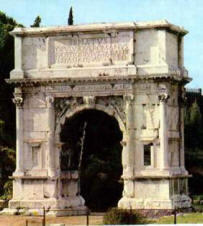 The
biblical celebration of Weeks requires the presence of the Temple on the
Temple Mount. Today there is no Temple as a result of the Roman destruction
of A.D. 70; therefore the modern celebration differs from the Biblical
celebration.
The
biblical celebration of Weeks requires the presence of the Temple on the
Temple Mount. Today there is no Temple as a result of the Roman destruction
of A.D. 70; therefore the modern celebration differs from the Biblical
celebration.
The destruction of the Temple goes back to Jewish rebellion against Roman occupation. The Roman occupation of Jerusalem began when General Pompey conquered Jerusalem in 63 B.C. Since that time Rome was involved in the rule of Israel. This reached boiling point over 100-years later when the Jews of Jerusalem rebelled against Roman rule.
The Roman general Titus (30-81), son of the emperor Vespasian, was sent to crush the rebellion. The rebellion began in A.D. 66 and lasted until A.D. 70 when Titus conquered the city of Jerusalem. In the conquest of Jerusalem the walls of the city were destroyed, along with the Temple, by the armies of Rome. Part of one of the walls was used to establish a Roman garrison in the city. According to Josephus over 1 million Jews were killed by the Romans.
The Romans celebrated
their victory of Jerusalem by minting coins with the inscription of “Judea
Capta” Judea was pictured as a woman weeping under a palm tree with another
captive standing to the side. Titus became emperor and celebrated his
victory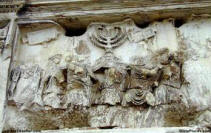 with the “Arch of Titus” with scenes depicting his victory over Jerusalem.
with the “Arch of Titus” with scenes depicting his victory over Jerusalem.
One scene depicts the removal of the Golden Menorah from the Temple by the Roman soldiers. Jews were scattered throughout the Roman Empire and surrounding lands.
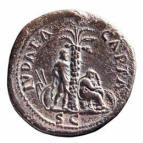 In
117 A.D., the Emperor Hadrian came to the throne. At first things seemed
like they would be better for the Jews living in the Roman Empire and
Palestine. Things turned for the worst when Hadrian, in 130 A.D., insisted
on imposing Roman and Greek culture on Jerusalem. Construction on the Roman
Temple at Mount Moriah began causing the Jews to rebel again.
In
117 A.D., the Emperor Hadrian came to the throne. At first things seemed
like they would be better for the Jews living in the Roman Empire and
Palestine. Things turned for the worst when Hadrian, in 130 A.D., insisted
on imposing Roman and Greek culture on Jerusalem. Construction on the Roman
Temple at Mount Moriah began causing the Jews to rebel again.
In 132 A.D., under the leadership of Simon Bar Kochba, the Jews were able to liberate Jerusalem from Roman occupation. The most celebrated rabbi of his day, and leader of the Sanhedrin, Rabbi Akiba, declared Bar Kochba the Messiah. Kochba minted coins depicting the Temple to be rebuilt. Jerusalem was filled with Messianic fever as events progressed. The Jews of Jerusalem looked forward to the Messianic age. Hadrian would not have it; he came to Jerusalem with his best troops to crush the rebellion.
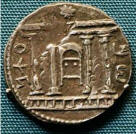 In
135 A.D. the Jewish rebellion was crushed and Bar Kochba was killed at his
fortress city of Betar. The Romans killed over 580,000 Jews and thousands
were sold into slavery. The city of Jerusalem was again destroyed, and the
Jews were forbidden entry into the new city. Hadrian seethed with rage; he
wanted to erase the name of the city of Jerusalem and the name of Judea. He
renamed the land Palestine after the Philistines and Jerusalem was called
Aelia Capitolina. He then erected a temple to Jupiter on Mount Moriah to
desecrate the site of the Temple. Hadrian issued a coin with a yoke of oxen
plowing the new foundations of the Temple.
In
135 A.D. the Jewish rebellion was crushed and Bar Kochba was killed at his
fortress city of Betar. The Romans killed over 580,000 Jews and thousands
were sold into slavery. The city of Jerusalem was again destroyed, and the
Jews were forbidden entry into the new city. Hadrian seethed with rage; he
wanted to erase the name of the city of Jerusalem and the name of Judea. He
renamed the land Palestine after the Philistines and Jerusalem was called
Aelia Capitolina. He then erected a temple to Jupiter on Mount Moriah to
desecrate the site of the Temple. Hadrian issued a coin with a yoke of oxen
plowing the new foundations of the Temple.
GIVING TORAH
As a result of the destruction of the Temple and Jerusalem no longer could the Feast of Weeks be performed. Therefore the Sanhedrin, in A.D. 140, met in the village of Usha near modern Haifa to decide what to do? They determined Shavuot (Weeks) was the day the Torah was given to Moses on Mount Sinai. Shavuot became known as Zeman Mattan Toraenu, “the Time of the Giving of our Law”.
SYNAGOGUE
To celebrate Shavuot today beautiful floral arrangements are hung in synagogues. Embroidered green curtains are hung over the ark where the Torah scroll is stored. These are meant to be reminders that Mt. Sinai was once covered with green trees and grass.
Ancient scripture readings are read reflecting on the glorious presence of the Lord. (Ezekiel 1:1-28, 3:12; Hab. 2:20-3:19) These readings date back to the time of the Temple.
Ezekiel 1:4,24-28
4 Then I looked, and behold, a whirlwind was coming out of the north, a great cloud with raging fire engulfing itself; and brightness was all around it and radiating out of its midst like the color of amber, out of the midst of the fire. 24 When they went, I heard the noise of their wings, like the noise of many waters, like the voice of the Almighty, a tumult like the noise of an army; and when they stood still, they let down their wings. 25 A voice came from above the firmament that was over their heads; whenever they stood, they let down their wings. 26 And above the firmament over their heads was the likeness of a throne, in appearance like a sapphire stone; on the likeness of the throne was a likeness with the appearance of a man high above it. 27 Also from the appearance of His waist and upward I saw, as it were, the color of amber with the appearance of fire all around within it; and from the appearance of His waist and downward I saw, as it were, the appearance of fire with brightness all around. 28 Like the appearance of a rainbow in a cloud on a rainy day, so was the appearance of the brightness all around it. This was the appearance of the likeness of the glory of the LORD.
Habakkuk 3:3-5
3 God came from Teman, The Holy One from Mount Paran. Selah. His glory covered the heavens, And the earth was full of His praise. 4 His brightness was like the light; He had rays flashing from His hand, And there His power was hidden. 5 Before Him went pestilence, And fever followed at His feet.
The story of Ruth is also read in the synagogue during this time because Ruth was Moabite who embraced the law of Moses. The book of Ruth took place at the time of the Barley harvest, and Weeks is a celebration of the Wheat Harvest which comes after the Barley harvest.
FOOD
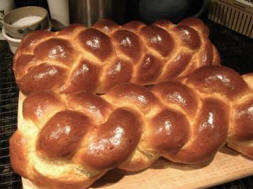 Dairy
products are part of the celebration of Weeks. Since scripture is depicted
as the Milk and Honey of the soul it is also customary to bake two Hallah
loaves of Bread on Shavuot to represent the two loaves offered in the Temple
and the two tablets of the Law given to Moses on Mt. Sinai.
Dairy
products are part of the celebration of Weeks. Since scripture is depicted
as the Milk and Honey of the soul it is also customary to bake two Hallah
loaves of Bread on Shavuot to represent the two loaves offered in the Temple
and the two tablets of the Law given to Moses on Mt. Sinai.
STAYING UP ALL NIGHT
Observant Jews will also stay up the entire night discussing and studying Torah. During the night there are breaks for coffee and cheesecake. Discussion revolve around the opening and closing scriptures of each Sabbath reading, the opening and closing verses of each book of the Bible, and the entire book of Ruth. In the morning thousands of Jews wind their way toward the site of the Temple and pour onto the Western Wall plaza, there they read the The Amidah “the Standing”
THE FULFILLMENT
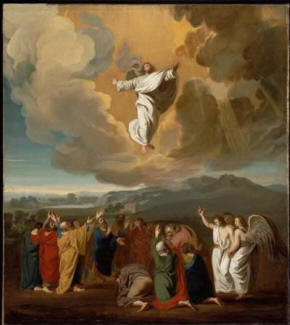 Jesus
was our Passover Lamb for the redemption of humanity. His blood allowed
death to Passover our sins, since he took our sins upon Himself. Jesus was
in the grave, but he did not decay, fulfilling the picture of the Feast of
Unleavened Bread. Then Jesus rose on the Feast of Firstfruits, Himself being
the Firstfruit of the resurrection. Jesus instructed His followers to remain
in Jerusalem until they receive the promise of the Father, the baptism of
the Holy Spirit.
Jesus
was our Passover Lamb for the redemption of humanity. His blood allowed
death to Passover our sins, since he took our sins upon Himself. Jesus was
in the grave, but he did not decay, fulfilling the picture of the Feast of
Unleavened Bread. Then Jesus rose on the Feast of Firstfruits, Himself being
the Firstfruit of the resurrection. Jesus instructed His followers to remain
in Jerusalem until they receive the promise of the Father, the baptism of
the Holy Spirit.
Acts 1:1-10
4 On one occasion, while he was eating with them, he gave them this command: Do not leave Jerusalem, but wait for the gift my Father promised, which you have heard me speak about. 5 For John baptized with water, but in a few days you will be baptized with the Holy Spirit. 6 So when they met together, they asked him, Lord, are you at this time going to restore the kingdom to Israel? 7 He said to them: It is not for you to know the times or dates the Father has set by his own authority. 8 But you will receive power when the Holy Spirit comes on you; and you will be my witnesses in Jerusalem, and in all Judea and Samaria, and to the ends of the earth. 9 After he said this, he was taken up before their very eyes, and a cloud hid him from their sight. 10 They were looking intently up into the sky as he was going, when suddenly two men dressed in white stood beside them. 11 Men of Galilee," they said, "why do you stand here looking into the sky? This same Jesus, who has been taken from you into heaven, will come back in the same way you have seen him go into heaven.
On the fiftieth day, during the Feast of Weeks, the Holy Spirit descended upon the followers of Christ who had gathered in the Upper room to celebrate the feast. The church is the harvest of Messiah’s redemption in this age. We are the bread of the harvest. Those who had gathered in the upper room were the first fruits of the “Wheat Harvest”. They were both Jews and Gentiles, the two loaves, with their sins before the Lord, they had “Leaven” in their midst.
Acts 2:1-13
1 When the day of Pentecost came, they were all together in one place. 2 Suddenly a sound like the blowing of a violent wind came from heaven and filled the whole house where they were sitting. 3 They saw what seemed to be tongues of fire that separated and came to rest on each of them. 4 All of them were filled with the Holy Spirit and began to speak in other tongues as the Spirit enabled them. 5 Now there were staying in Jerusalem God-fearing Jews from every nation under heaven. 6 When they heard this sound, a crowd came together in bewilderment, because each one heard them speaking in his own language. 7 Utterly amazed, they asked: Are not all these men who are speaking Galileans? 8 Then how is it that each of us hears them in his own native language? 9 Parthians, Medes and Elamites; residents of Mesopotamia, Judea and Cappadocia, Pontus and Asia, 10 Phrygia and Pamphylia, Egypt and the parts of Libya near Cyrene; visitors from Rome 11 (both Jews and converts to Judaism); Cretans and Arabs-we hear them declaring the wonders of God in our own tongues! 12 Amazed and perplexed, they asked one another, What does this mean? 13 Some, however, made fun of them and said, They have had too much wine.
On the Feast of Shavuot the first fruit of the Wheat Harvest is celebrated and the harvest of Wheat has begun. This harvest will continue until the Fall when the Fall Harvest is celebrated. Today we the believers are part of the “Wheat” Harvest until the Seventh Month when the End Times will begin. Jesus alludes to this in the Gospel of John, when he refers to the souls from Sycar as the souls of the harvest to be reaped between the 4th and 7th Month of the year.
John 4:27-39
27 Just then his disciples returned and were surprised to find him talking with a woman. But no one asked, What do you want? or Why are you talking with her? 28 Then, leaving her water jar, the woman went back to the town and said to the people, 29 Come, see a man who told me everything I ever did. Could this be the Christ? 30 They came out of the town and made their way toward him. 31 Meanwhile his disciples urged him, Rabbi, eat something. 32 But he said to them, I have food to eat that you know nothing about.
33 Then his disciples said to each other, Could someone have brought him food? 34 My food, said Jesus, is to do the will of him who sent me and to finish his work. 35 Do you not say, Four months more and then the harvest? I tell you, open your eyes and look at the fields! They are ripe for harvest. 36 Even now the reaper draws his wages; even now he harvests the crop for eternal life, so that the sower and the reaper may be glad together. 37 Thus the saying One sows and another reaps' is true. 38 I sent you to reap what you have not worked for. Others have done the hard work, and you have reaped the benefits of their labor. 39 Many of the Samaritans from that town believed in him because of the woman's testimony, He told me everything I ever did. 40 So when the Samaritans came to him, they urged him to stay with them, and he stayed two days. 41 And because of his words many more became believers.
